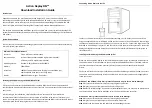
WWW.TMGINDUSTRIAL.COM
11 / 33
Toll Free:1-877-761-2819
Escaping fluid under pressure can have sufficient force to penetrate the skin causing serious personal injury. Fluid escaping
from a very small hole can be almost invisible. Use a piece of cardboard or wood, rather than hands to search for suspected
leaks. Keep unprotected body parts, such as face, eyes, and arms as far away as possible from a suspected leak. Flesh
injected with hydraulic fluid may develop gangrene, or other permanent disabilities.
9.
Hook up the hydraulic system to the tractor with the hydraulic pressure going to the backhoe inline filter and coming from
the backhoe check valve and going to the tractor.
We recommend that you involve your dealer for the initial hydraulic hook-up. Install the correct hydraulic couplers that fit your
tractor onto the backhoe pressure and return hoses.
10.
Start the tractor engine and operate at low RPM. Activate the tractor valve to provide hydraulic power to the backhoe.
(Check for any hydraulic leaks.)
Until the backhoe is securely mounting onto the tractor, keep all people clear of your work area and make sure that no portion
of the operator’s body is beneath any part of the backhoe.
11.
Raise the backhoe using the stabilizer and boom control levers until the swing is approximately 20 cm above ground
level. Make sure the backhoe is vertical (perpendicular to the ground).
12.
Back the tractor until the lower link ball joints are in line with the mounting holes in the backhoe mainframe.
While backing tractor be aware of the location of the hydraulic hoses and top links.
13.
Install the hitch pins connecting the lower links to the backhoe mainframe. Secure in place using the two pins provided.
14.
Position the single top link in-between the double link, Adjust the backhoe height until at least one hole lines up between
the two links. Keep backhoe vertical while adjusting the height. Install the cap screw, two hard flat washers (both sides)
and lock nut provided.
15.
If the hitch lock-out arms were not installed at the factory, position them to the inside of the mounting holes, and bolt into
place using the two cap screws, hard flat washers (both sides), and lock nuts provided. Position the hitch lock-out arms
on each side of the top links, align one of the holes (as far away from the cap screw installed in step 16 as possible), and
install the cap screw, two hard flat washers (both sides), and lock nut provided.
It is important to pick a set of holes that place the backhoe in a vertical position in relationship to the ground with about 20 cm
of ground clearance at the boom pivot pin.
16.
Torque all mounting bolts. Refer to the torque chart of this manual.
17.
Check hose routing to ensure that they are kept away from the operator during backhoe operation. Do not let them touch
the ground. Secure all hydraulic lines in place for operator safety and to prevent them from being damaged.
18.
Double check clearance between the backhoe operator and any solid portion of the tractor, such as the cab or ROPS. If 20
cm of head clearance is not available, DO NOT USE THIS BACKHOE ON THIS TRACTOR. Failure to observe these
instructions my cause severe personal injury or death.













































